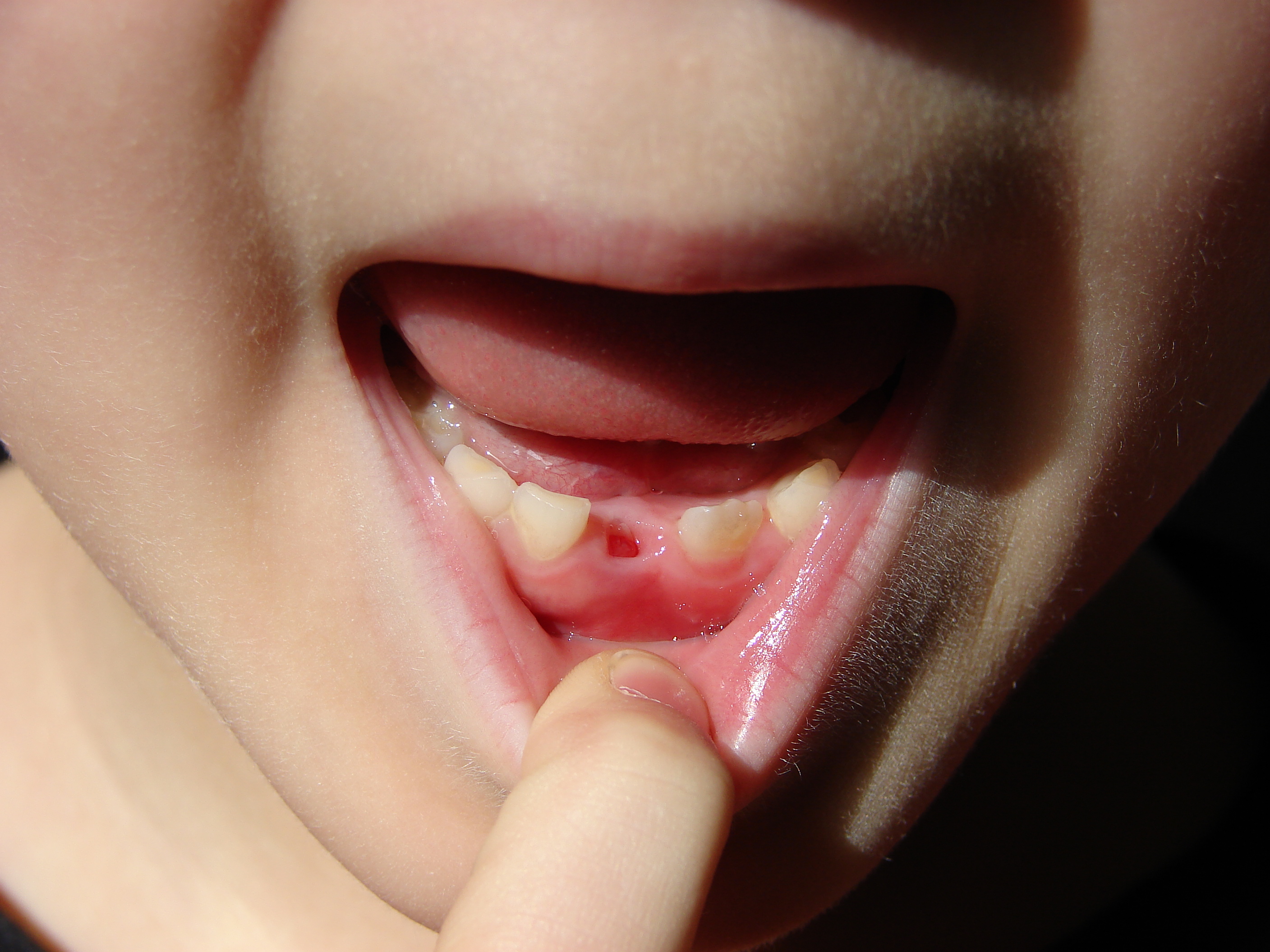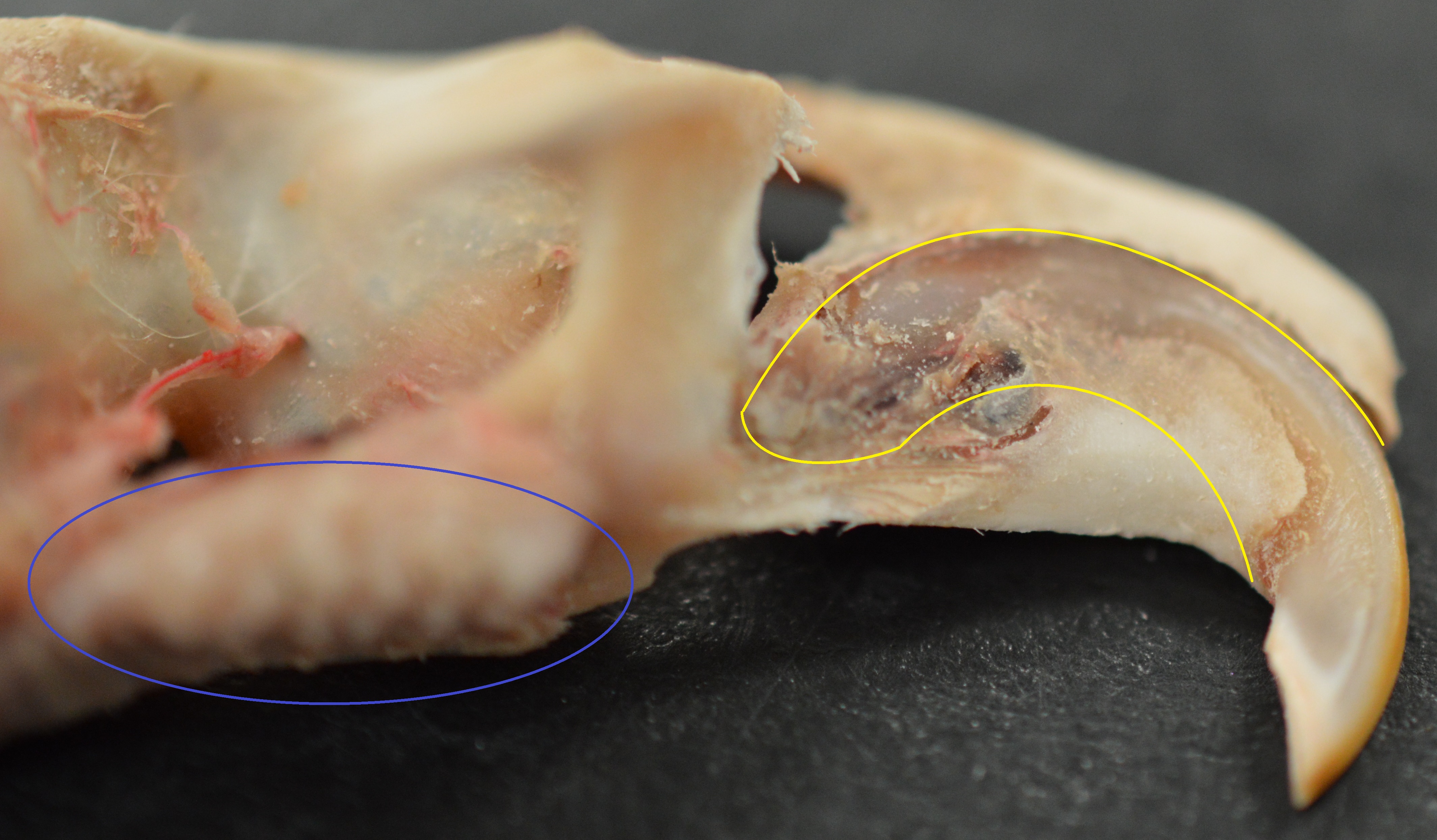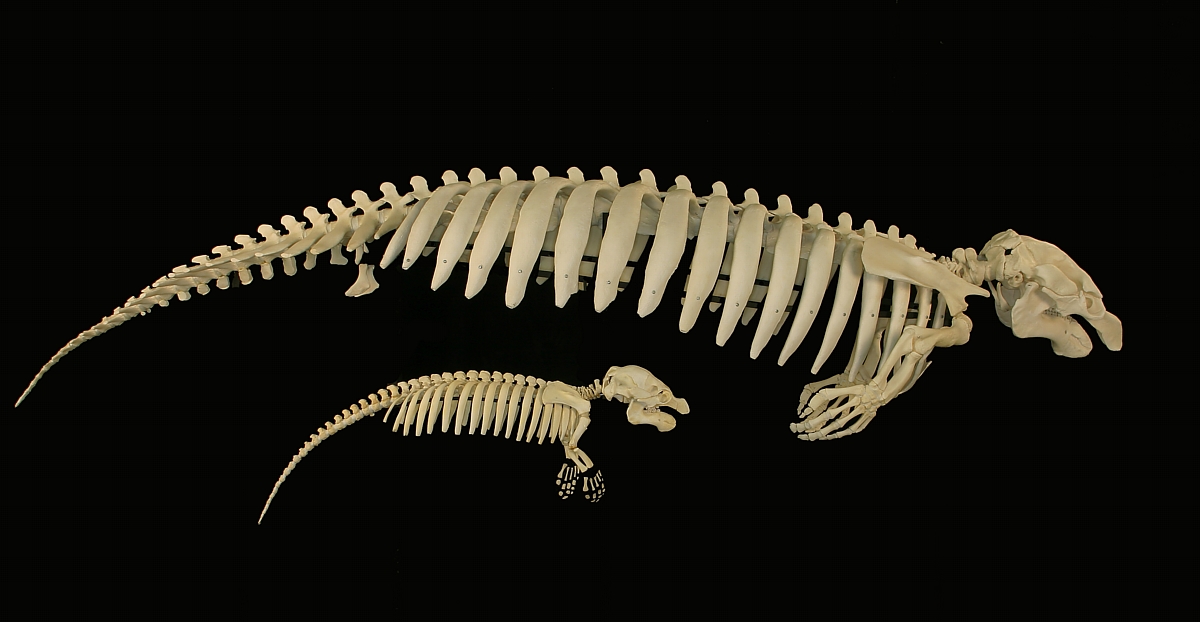|
Diphyodont
A diphyodont is any animal with two sets of teeth, initially the ''deciduous'' set and consecutively the '' permanent'' set. Most mammals are diphyodonts—as to chew their food they need a strong, durable and complete set of teeth. Diphyodonts contrast with ''polyphyodonts'', whose teeth are constantly replaced. Diphyodonts also differ from '' monophyodonts'', which are animals who have only one set of teeth that does not change over a long period of growth. In diphyodonts, the number of teeth that are replaced varies from species to species. In humans, a set of twenty deciduous teeth, or "milk teeth", are replaced by a completely new set of thirty-two adult teeth. In some cases hypodontia or hyperdontia occurs, the latter in cleidocranial dysostosis and Gardner's syndrome. In the hare the anterior incisors are not replaced but the posterior smaller incisors are replaced. Not much is known about the developmental mechanisms regulating diphyodont replacement. The house shre ... [...More Info...] [...Related Items...] OR: [Wikipedia] [Google] [Baidu] |
Tooth (animal)
A tooth (: teeth) is a hard, calcified structure found in the jaws (or mouths) of many vertebrates and used to break down food. Some animals, particularly carnivores and omnivores, also use teeth to help with capturing or wounding prey, tearing food, for defensive purposes, to intimidate other animals often including their own, or to carry prey or their young. The roots of teeth are covered by gums. Teeth are not made of bone, but rather of multiple tissues of varying density and hardness that originate from the outermost embryonic germ layer, the ectoderm. The general structure of teeth is similar across the vertebrates, although there is considerable variation in their form and position. The teeth of mammals have deep roots, and this pattern is also found in some fish, and in crocodilians. In most teleost fish, however, the teeth are attached to the outer surface of the bone, while in lizards they are attached to the inner surface of the jaw by one side. In cartilaginous f ... [...More Info...] [...Related Items...] OR: [Wikipedia] [Google] [Baidu] |
Deciduous Teeth
Deciduous teeth or primary teeth, also informally known as baby teeth, milk teeth, or temporary teeth,Fehrenbach, MJ and Popowics, T. (2026). ''Illustrated Dental Embryology, Histology, and Anatomy'', 6th edition, Elsevier, page 287–296. are the first set of teeth in the growth and development of humans and other diphyodonts, which include most mammals but not elephants, kangaroos, or manatees, which are polyphyodonts. Deciduous teeth Animal tooth development, develop during the embryonic stage of development and tooth eruption, erupt (break through the gums and become visible in the mouth) during infancy. They are usually lost and replaced by permanent teeth, but in the absence of their permanent replacements, they can remain functional for many years into adulthood. Development Formation Primary teeth start to form during the embryonic phase of human development (biology), human life. The development of primary teeth starts at the sixth week of tooth development as the d ... [...More Info...] [...Related Items...] OR: [Wikipedia] [Google] [Baidu] |
Monophyodont
A tooth (: teeth) is a hard, calcified structure found in the jaws (or mouths) of many vertebrates and used to break down food. Some animals, particularly carnivores and omnivores, also use teeth to help with capturing or wounding prey, tearing food, for defensive purposes, to intimidate other animals often including their own, or to carry prey or their young. The roots of teeth are covered by gums. Teeth are not made of bone, but rather of multiple tissues of varying density and hardness that originate from the outermost embryonic germ layer, the ectoderm. The general structure of teeth is similar across the vertebrates, although there is considerable variation in their form and position. The teeth of mammals have deep roots, and this pattern is also found in some fish, and in crocodilians. In most teleost fish, however, the teeth are attached to the outer surface of the bone, while in lizards they are attached to the inner surface of the jaw by one side. In cartilaginous fis ... [...More Info...] [...Related Items...] OR: [Wikipedia] [Google] [Baidu] |
Dentition Types
Dentition pertains to the development of teeth and their arrangement in the mouth. In particular, it is the characteristic arrangement, kind, and number of teeth in a given species at a given age. That is, the number, type, and morpho-physiology (that is, the relationship between the shape and form of the tooth in question and its inferred function) of the teeth of an animal. Terminology Animals whose teeth are all of the same type, such as most non-mammalian vertebrates, are said to have ''homodont'' dentition, whereas those whose teeth differ morphologically are said to have ''heterodont'' dentition. The dentition of animals with two successions of teeth (deciduous, permanent) is referred to as ''diphyodont'', while the dentition of animals with only one set of teeth throughout life is ''monophyodont''. The dentition of animals in which the teeth are continuously discarded and replaced throughout life is termed ''polyphyodont''. The dentition of animals in which the teeth are ... [...More Info...] [...Related Items...] OR: [Wikipedia] [Google] [Baidu] |
Monophyodonts
A tooth (: teeth) is a hard, calcified structure found in the jaws (or mouths) of many vertebrates and used to break down food. Some animals, particularly carnivores and omnivores, also use teeth to help with capturing or wounding prey, tearing food, for defensive purposes, to intimidate other animals often including their own, or to carry prey or their young. The roots of teeth are covered by gums. Teeth are not made of bone, but rather of multiple tissues of varying density and hardness that originate from the outermost embryonic germ layer, the ectoderm. The general structure of teeth is similar across the vertebrates, although there is considerable variation in their form and position. The teeth of mammals have deep roots, and this pattern is also found in some fish, and in crocodilians. In most teleost fish, however, the teeth are attached to the outer surface of the bone, while in lizards they are attached to the inner surface of the jaw by one side. In cartilaginous fis ... [...More Info...] [...Related Items...] OR: [Wikipedia] [Google] [Baidu] |
Polyphyodont
A polyphyodont is any animal whose tooth (animal), teeth are continually replaced. In contrast, diphyodonts are characterized by having only two successive sets of teeth. Polyphyodonts include most toothed fishes (most notably sharks), many reptiles such as crocodiles and geckos, and most other vertebrates, with mammals being the main exception (though Polyphyodont#Evolution in mammals, not absolute). Growth New, permanent teeth grow in the jaws, usually under or just behind the old tooth, from stem cells in the dental lamina. Young animals typically have a full set of teeth when they hatch; there is no tooth change in the egg. Within days, tooth replacement begins, usually in the back of the jaw continuing forward like a wave. On average a tooth is replaced every few months. Crocodilia Crocodilia are the only non-mammalian vertebrates with tooth sockets. Alligators grow a successional tooth (a small replacement tooth) under each mature functional tooth for replacement once a y ... [...More Info...] [...Related Items...] OR: [Wikipedia] [Google] [Baidu] |
Permanent Teeth
Permanent teeth or adult teeth are the second set of teeth formed in diphyodont mammals. In humans and old world simians, there are thirty-two permanent teeth, consisting of six maxillary and six mandibular molars, four maxillary and four mandibular premolars, two maxillary and two mandibular canines, four maxillary and four mandibular incisors. Timeline The first permanent tooth usually appears in the mouth at around 5-6 years of age, and the mouth will then be in a transition time with both primary (or deciduous dentition) teeth and permanent teeth during the mixed dentition period until the last primary tooth is lost or shed. The first of the permanent teeth to erupt are the permanent first molars, right behind the last 'milk' molars of the primary dentition. These first permanent molars are important for the correct development of a permanent dentition. Up to thirteen years of age, 28 of the 32 permanent teeth will appear. The full permanent dentition is completed much l ... [...More Info...] [...Related Items...] OR: [Wikipedia] [Google] [Baidu] |
Polyphyodont
A polyphyodont is any animal whose tooth (animal), teeth are continually replaced. In contrast, diphyodonts are characterized by having only two successive sets of teeth. Polyphyodonts include most toothed fishes (most notably sharks), many reptiles such as crocodiles and geckos, and most other vertebrates, with mammals being the main exception (though Polyphyodont#Evolution in mammals, not absolute). Growth New, permanent teeth grow in the jaws, usually under or just behind the old tooth, from stem cells in the dental lamina. Young animals typically have a full set of teeth when they hatch; there is no tooth change in the egg. Within days, tooth replacement begins, usually in the back of the jaw continuing forward like a wave. On average a tooth is replaced every few months. Crocodilia Crocodilia are the only non-mammalian vertebrates with tooth sockets. Alligators grow a successional tooth (a small replacement tooth) under each mature functional tooth for replacement once a y ... [...More Info...] [...Related Items...] OR: [Wikipedia] [Google] [Baidu] |
Heterodont
In anatomy, a heterodont (from Greek, meaning 'different teeth') is an animal which possesses more than a single tooth morphology. Human dentition is heterodont and diphyodont as an example. In vertebrates, heterodont pertains to animals where teeth are differentiated into different forms. For example, members of the Synapsida generally possess incisors, canines ("dogteeth"), premolars, and molars. The presence of heterodont dentition is evidence of some degree of feeding and or hunting specialization in a species. In contrast, homodont or isodont dentition refers to a set of teeth that possess the same tooth morphology. In invertebrates, the term heterodont refers to a condition where teeth of differing sizes occur in the hinge plate, a part of the Bivalvia Bivalvia () or bivalves, in previous centuries referred to as the Lamellibranchiata and Pelecypoda, is a class (biology), class of aquatic animal, aquatic molluscs (marine and freshwater) that have laterally co ... [...More Info...] [...Related Items...] OR: [Wikipedia] [Google] [Baidu] |
Manatees
Manatees (, family Trichechidae, genus ''Trichechus'') are large, fully aquatic, mostly herbivorous marine mammals sometimes known as sea cows. There are three accepted living species of Trichechidae, representing three of the four living species in the order Sirenia: the Amazonian manatee (''Trichechus inunguis''), the West Indian manatee (''Trichechus manatus''), and the West African manatee (''Trichechus senegalensis''). They measure up to long, weigh as much as , and have paddle-like tails. Manatees are herbivores and eat over 60 different freshwater and saltwater plants. Manatees inhabit the shallow, marshy coastal areas and rivers of the Caribbean Sea, the Gulf of Mexico, the Amazon basin, and West Africa. The main causes of death for manatees are human-related issues, such as habitat destruction and human objects. Their slow-moving, curious nature has led to violent collisions with propeller-driven boats and ships. Some manatees have been found with over 50 scars ... [...More Info...] [...Related Items...] OR: [Wikipedia] [Google] [Baidu] |
Thecodont Dentition
Thecodont dentition is a morphological arrangement in which the base of the tooth is completely enclosed in a deep socket of bone, as seen in crocodilians, dinosaurs and mammals, and opposed to acrodont and pleurodont dentition seen in squamate reptiles. Notably, this appears to be the ancestral tooth condition in Amniota Amniotes are tetrapod vertebrate animals belonging to the clade Amniota, a large group that comprises the vast majority of living terrestrial and semiaquatic vertebrates. Amniotes evolved from amphibious stem tetrapod ancestors during the C .... This morphology was once used as a basis for the now-defunct taxonomic group Thecodontia. References Dentition types Archosaurs {{Vertebrate anatomy-stub ... [...More Info...] [...Related Items...] OR: [Wikipedia] [Google] [Baidu] |
Schultz's Rule
Schultz's rule is a rule developed by Adolph Hans Schultz, declaring a relationship between the first tooth eruption of the molar versus the permanent teeth and the progress or aging of its carrier. It states that species that live longer have more wear on deciduous teeth and as a result start replacing them relatively early in life. Which is an indicator for examining fossil data. According to research, '' Myotragus balearicus'' follows Schultz's Rule. See also * Diphyodont * Polyphyodont * Tooth development A tooth (: teeth) is a hard, calcified structure found in the jaws (or mouths) of many vertebrates and used to break down food. Some animals, particularly carnivores and omnivores, also use teeth to help with capturing or wounding prey, teari ... References Further reading * * Tooth development Animal anatomy Paleontological concepts and hypotheses {{dentistry-stub ... [...More Info...] [...Related Items...] OR: [Wikipedia] [Google] [Baidu] |






